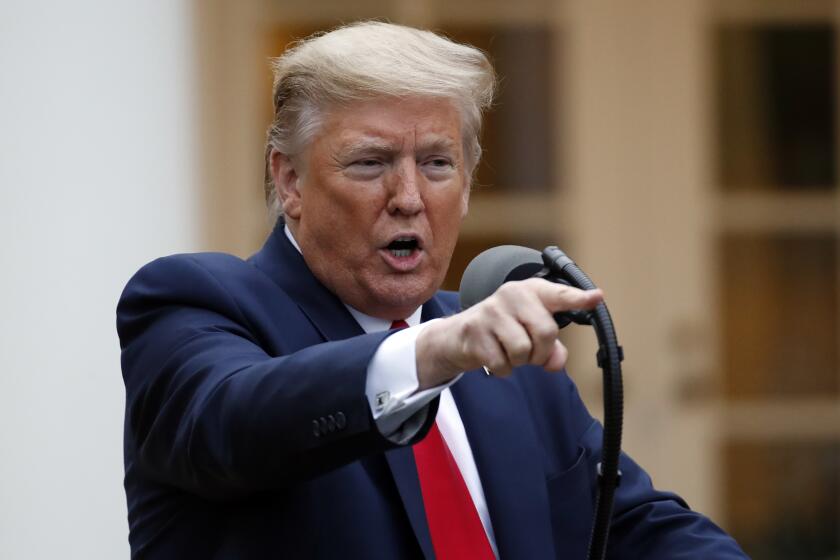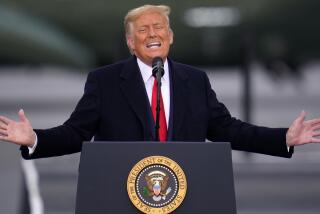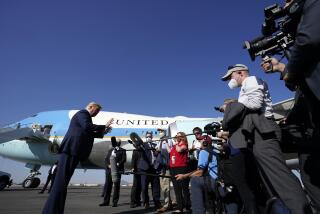Trump careened through a critical week in the coronavirus crisis
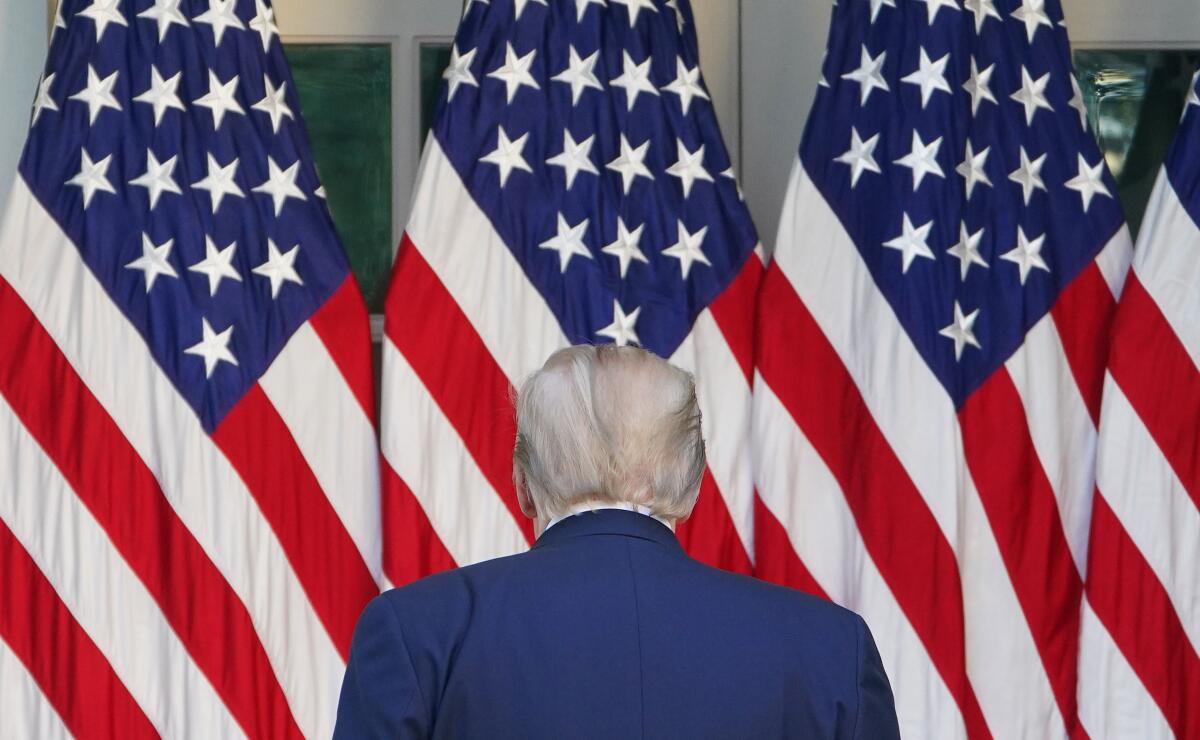
- Share via
WASHINGTON — When AFL-CIO President Richard Trumka was shown a draft last week of President Trump’s plan to reopen the economy, he worried it didn’t offer enough testing for the coronavirus to ensure that millions of Americans could safely return to work.
“I’ve heard people say we have all the tests we need,” Trumka said. “That’s just not the case right now on the ground.”
So after he was named to a presidential advisory group, Trumka planned to raise his concerns in a conference call. But with dozens dialed in, the head of the country’s largest federation of labor unions never got to speak.
In the end, it didn’t matter. The draft that Trumka saw Tuesday was the same set of guidelines that Trump announced Thursday, recommendations that took scant notice of crippling supply shortages and insufficient tests in much of the country.
Three months into the coronavirus pandemic, the U.S. still lacks an effective testing system. Each step in the process involves bottlenecks.
Days after Trump said he was considering “without question the biggest decision I’ve ever had to make,” he put the onus on the nation’s governors to shoulder the challenge — and assume the blame if the deadly virus doesn’t cooperate — rather than take responsibility himself.
Like many of Trump’s promises and announcements, his much-touted advisory councils — packed with corporate executives, Wall Street leaders and other boldfaced names — were more about public relations than substance, an attempt to create an appearance of support for what the president had already decided.
It was a week when the pandemic killed more Americans faster than ever before — more than 38,000 have perished since COVID-19 appeared — and the Labor Department reported that an unprecedented 22 million people had filed unemployment claims in the previous month.
But in what might have been the peak of the crisis, Trump offered contradictory and partisan messages, careening from one controversy to the next, while alternately boasting of his performance and grumbling about his media image.
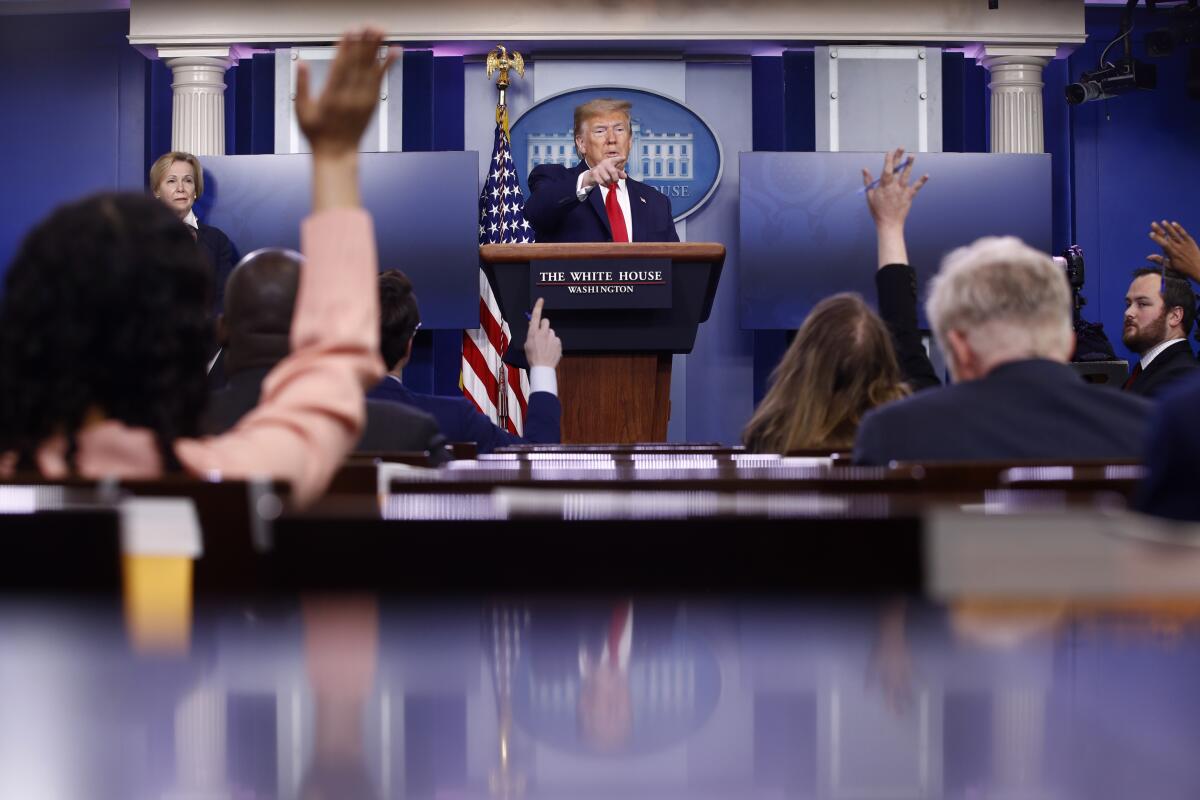
He fed his voracious television habit in the executive dining room off the Oval Office, often tweeting in response to cable news shows. After watching New York Gov. Andrew Cuomo, Trump complained that the Democrat was getting more favorable coverage than he was, according to an administration official, one of several people inside and outside of the White House who spoke on condition of anonymity. Others were getting too much credit, he groused, and he was getting too much blame.
Early in the week, he asserted unprecedented powers, claiming he had “total” authority to overrule governors on local regulations, and could unilaterally and arbitrarily adjourn Congress, neither of which was true. He backed down after members of his coronavirus task force proposed a framework states could use, according to another administration official.
On Thursday, he told governors in a conference call to “call your own shots” in lifting restrictions, relinquishing his role as national leader, only to urge his supporters Friday to “liberate” states with stay-at-home orders. Protests broke out in a half-dozen states on Saturday.
Protesters in Texas, Maryland, Indiana, Nevada and Wisconsin lobby against coronavirus restrictions. Trump criticizes Democratic governors.
Eric Bolling, a conservative television host who is close to the president, said the inconsistent message appeared to be the result of presidential whiplash as reporters demanded to know why Trump didn’t take stronger action to fight the pandemic, then criticized him for claiming more power than the Constitution allows.
“I saw a frustrated president who doesn’t hide from a fight ... get sucked into a fight he probably wished he hadn’t engaged in,” he said.
Inadequate testing arguably has been the Trump administration’s greatest shortcoming, dating to the earliest days of the outbreak. Public health experts argue that mass testing is necessary to show who is infected and who needs to be isolated, so that Americans will feel confident to safely return to work and normal life.
These are some of the unusual new scenes across the Southland during the coronavirus outbreak.
Trump has brushed off those concerns while trying to shift responsibility to governors.
“The problem is the states aren’t really in a position to do that,” Sen. Angus King, a Maine independent who caucuses with Democrats, said in an interview. “They have to fend for themselves in the private market and it’s only the federal administration that has the power and oversight to develop the testing infrastructure.”
In response, Trump complained Saturday that King and Senate Democrats had been “fresh,” “nasty,” and “rude” to Vice President Mike Pence on a conference call about testing.
Even many of the business leaders Trump recruited for his advisory councils say they don’t want to push ahead without more testing.
Wolfgang Puck, the celebrity chef who has been on two recent calls with Trump, said he’s “bored” at home and would “like nothing more” than to reopen his restaurants. But “we want our employees to be safe. We want our customers to be safe first,” he said.
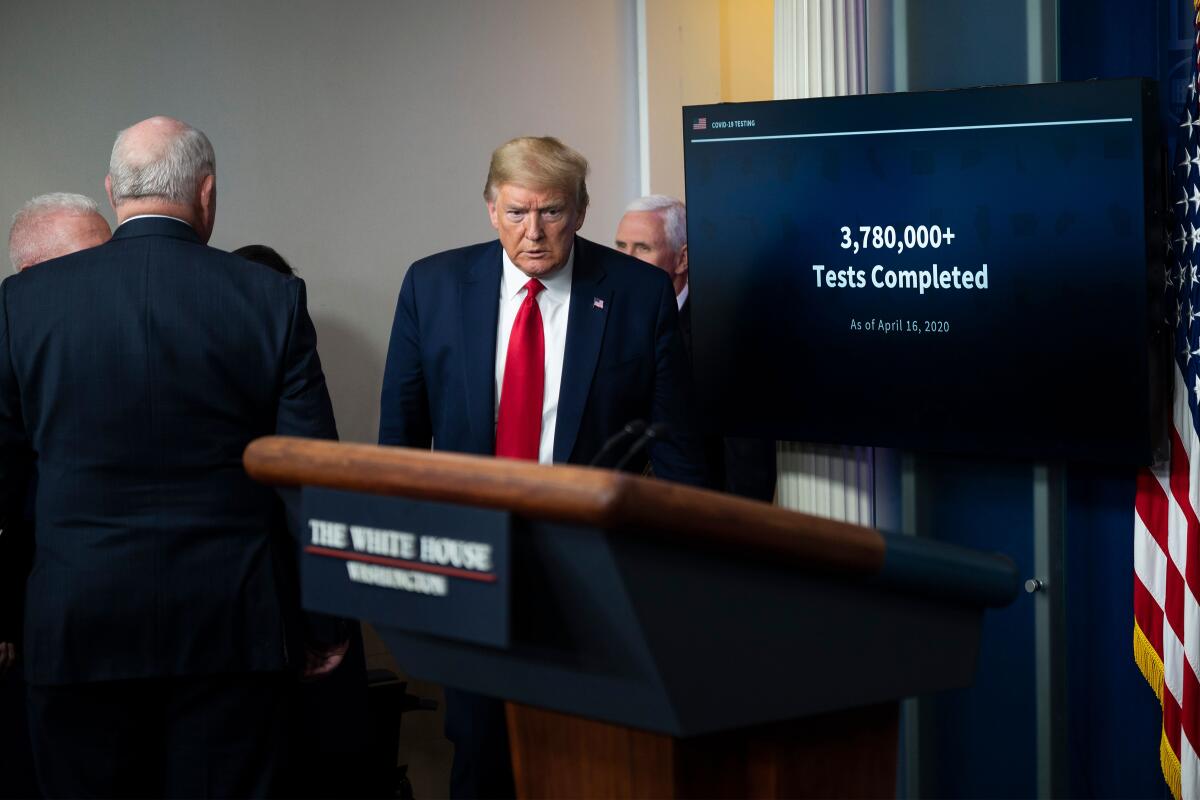
Even though Trump has declared himself a “wartime president” in the battle against a “cruel virus from a distant land,” he has repeatedly focused on battling his political enemies or waging rearguard action against dysfunction in his own administration.
Michael Caputo was named communications advisor to Secretary of Health and Human Services Alex Azar, who Trump has blamed for negative stories about his response to the pandemic. Caputo, a former Trump campaign aide, has no background in public health or medicine.
After starting his new job, he tweeted a snippet of a music video on Friday. “Don’t call it a comeback,” rapped LL Cool J.
Jared Kushner, the president’s son-in-law and senior advisor, became the target of sniping at the White House after he helped arrange the advisory councils, an administration official said, and some members only learned of them when Trump read their names aloud in the Rose Garden.
Arthur Laffer, a conservative economist, was driving in Tennessee, where he lives, when a friend called to say Trump had selected him. “I was flattered to be included,” he said.
Eager to show progress in the coronavirus crisis, President Trump meets people who have recovered from COVID-19, but continues to tout unproven drug.
For his part, Trump refused to set aside past rivalries or political grudges despite the gravity of the pandemic.
When he recruited senators to discuss next steps on a conference call Thursday, he included several Democrats and every Republican except Mitt Romney of Utah, the only Republican who voted to remove him from office during his impeachment trial in February.
Congress is considering replenishing funding for a bailout of small businesses hammered by the coronavirus, but Trump hasn’t spoken to House Speaker Nancy Pelosi (D-San Francisco), who led the impeachment drive.
Trump led coronavirus briefings at the White House every evening last week, holding forth for more than two hours on some days and commandeering the nation’s attention in lieu of barnstorming for his reelection campaign.
Much of Saturday’s briefing was unrelated to the pandemic. The president instead attacked the media and Democrats while riffing about everything from AIDS in Africa to his own travel schedule.
“When you don’t do rallies, this is the next best thing,” said a Republican close to the White House.
Times staff writer Jennifer Haberkorn contributed to this report.
More to Read
Get the L.A. Times Politics newsletter
Deeply reported insights into legislation, politics and policy from Sacramento, Washington and beyond. In your inbox three times per week.
You may occasionally receive promotional content from the Los Angeles Times.
